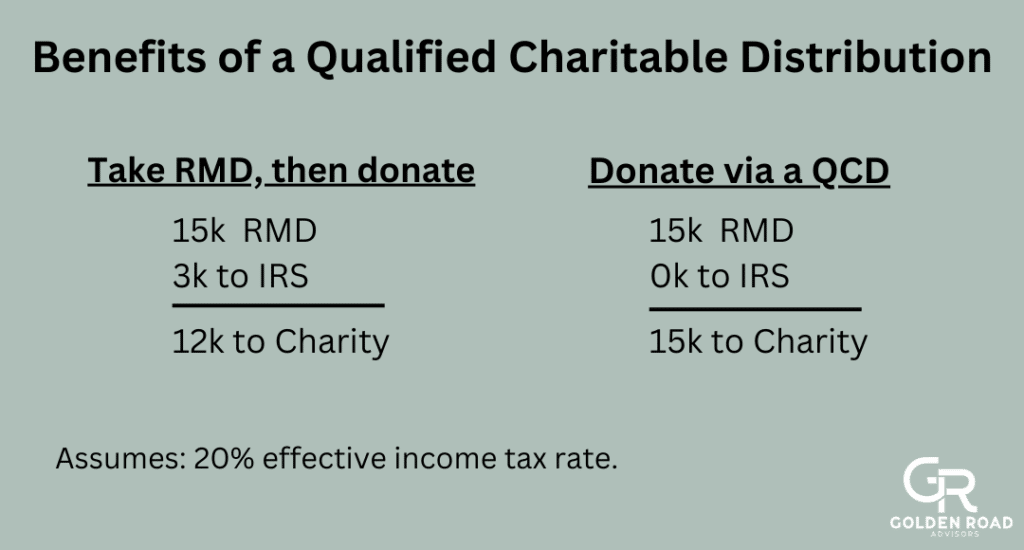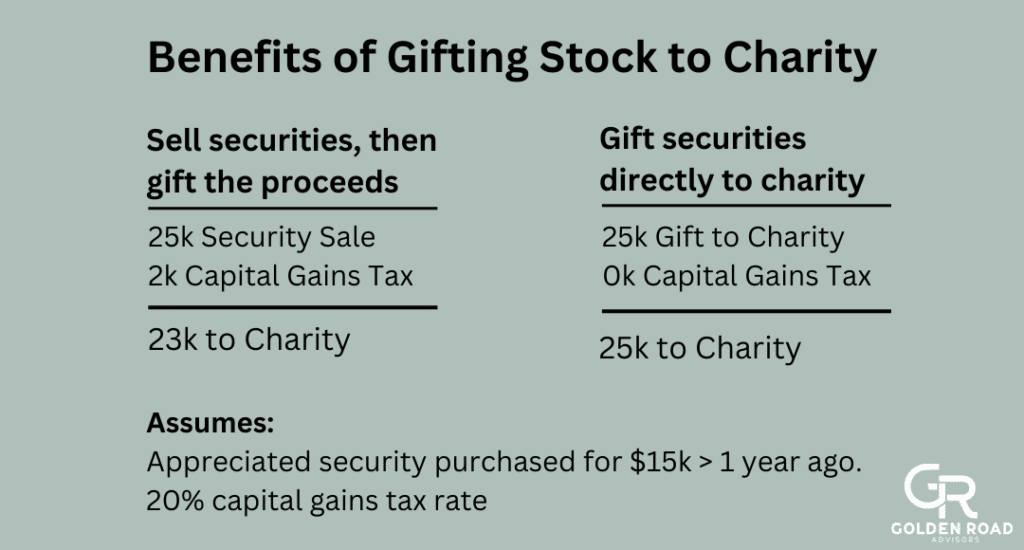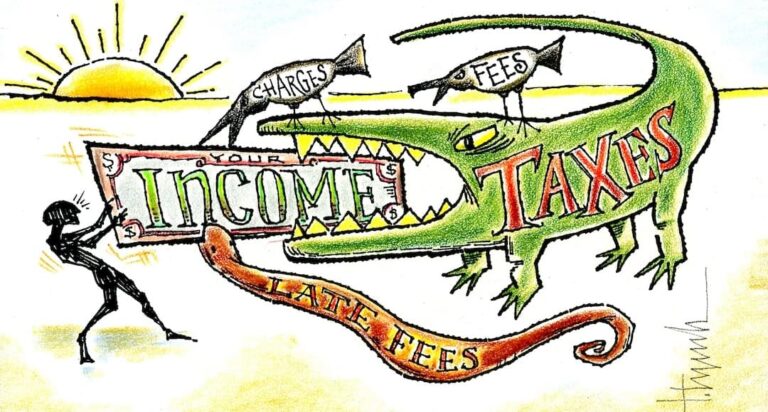
As we move toward the end of the year, you might be starting to think about the holiday season. But before your calendar fills with festivities, please take a moment to review your finances and the year-end tax planning strategies below so you can avoid a tax surprise this spring.
At Golden Road Advisors, we have been scheduling paystub and retirement income reviews with our clients to do this together. The following text will help you understand what to expect or what you can explore on your own.
Preparing for Year-End Tax Planning
The objective of end-of-year tax planning is to determine how much income you expect before year-end and how that compares to your financial goals so you can develop strategies to maximize your wealth and minimize costs. It is vital to do this in September or October each year while there is still time to make adjustments.
There are essentially two ways we can affect things:
- Control how much taxable income you receive in the calendar year (reducing or increasing depending on the average tax rate) and
- Offset taxable income by taking all possible tax deductions.
Therefore, to prepare for this work, gather together the following:
- A current paystub (if you are working)
- A tally of all other ordinary income you will receive this year, such as
- Business Income (YTD salary, plus YTD profit and loss statement)
- Interest Income
- Rental Income or Royalties
- Required Minimum Distributions (from retirement accounts)
- Social Security Income
- Pension Income
- Annuity Income
- An estimate of any income or losses you will incur in taxable investment accounts before year-end (distributions typically occur in November and December)
- Any income or losses from the sale of individual assets or stocks, such as stock grants received from your employer
Then, pull it all together to get a sense of the big picture. Are you taking advantage of all opportunities to build wealth? Do you expect a high or low tax year? Does it make sense to defer income opportunities, thus reducing your tax bill? Alternatively, does it make sense to accelerate income for this tax year?
Consider these questions (and more), then, depending on your circumstances, explore whether the following strategies can help. Also, download our checklist to keep key dates at your fingertips.
Year-End Tax Planning Strategies
1. Update Paycheck Withholdings
Updating your withholdings is vital if you have experienced significant changes this year. If you don’t withhold enough, you could get a surprise tax bill; if you withhold too much, it’s like giving an interest-free loan to the government. What can trigger an issue here?
- A job change
- A raise or a huge bonus
- The birth of a child or a change in your child’s dependency status
- A divorce
- A death
Taxes are typically the last thing you think of when these events occur, but now is the time to check in to see if you need to tweak your withholdings.
2. Maximize Your Retirement Savings Opportunities
Make sure you have taken full advantage of your retirement-saving opportunities. If you are in a position to contribute the maximum amount to these accounts, please do. You can add funds on a pre-tax basis, thereby reducing your taxable income. But there are also after-tax options to consider heavily.
For those who cannot afford to maximize their retirement plan contributions, at the very least, take advantage of any employer-matching opportunities. For example, if your employer matches contributions up to 3% of your eligible compensation and you earn $100,000 annually, aim to tuck away at least $3,000. Your employer will also contribute $3,000, doubling your money immediately.
The individual contribution limits (and deadlines) set by the IRS are as follows:
- 401k Contribution Limits (2023)
- $22,500 (plus $7,500 for people age 50 or older)
- Must occur by December 31, 2023
- Please note: If you wish to save more, check if your 401k plan allows after-tax contributions. The total IRS limit for contributions into a 401k is $66,000. You can contribute up to that limit if after-tax contributions are permitted and employee + employer contributions are less than $66,000 ($73,500 for those 50 and older).
- IRA Contribution Limits (2023)
- $6,500 (plus $1,000 for people 50 or older)
- Must occur by April 15, 2024
If your company offers a Roth 401k or your income level makes you eligible for a Roth IRA, I encourage you to take advantage of it. Roth retirement accounts only take after-tax dollars. So you sacrifice the tax break today, but your earnings grow tax-free forever, leading to a more tax-efficient nest egg in retirement.
If your income is too high to contribute directly to a Roth IRA, the strategy we will share next is potentially for you.
3. Consider a Backdoor Roth IRA or Roth IRA Conversion

Individuals and families with income above certain thresholds are ineligible for direct Roth IRA contributions. That is a shame because Roth retirement accounts offer benefits that traditional IRAs lack. Fortunately, there are financial strategies for getting around this challenge.
- Backdoor Roth IRA
The backdoor Roth IRA strategy involves making post-tax contributions to a traditional IRA and immediately converting those funds to a Roth IRA. This option is best for people who have maximized their employer match inside a 401k and do not have an existing traditional IRA account.
The deadline for completing a backdoor Roth for 2023 is April 15, 2024, when your personal tax returns are due. Because of this deadline, some like to simplify the process by converting two years worth of contributions simultaneously. - Roth IRA Conversion
The Roth conversion strategy involves taking pre-tax money from a traditional retirement account and converting it to a Roth account. This option is best for people with a traditional IRA account and enough cash to pay taxes on the converted funds.
The deadline for completing a Roth conversion is December 31, 2023.
These strategies can result in tax liabilities, so it is best to perform them with the help of a financial professional who can assess your unique situation.
4. Manage and Take Advantage of Your Health Care Savings Plan
If you have a Health Savings Plan (HSA) or a Flexible Spending Account (FSA), you must manage it correctly to maximize the benefits and avoid wasting money. When we perform a paystub review, we ensure you are on track to make all your contributions and correct any mishaps. Below are the essential things to remember about two of the most common healthcare savings accounts.
- Flexible Spending Accounts (FSAs)
- Allow you to set aside pre-tax money to pay for qualified medical expenses, reducing your taxable income and medical costs.
- FSA Contribution Limits (2023) = $3,050.
- You choose how much you will save each year but cannot adjust the amount once decided.
- Deadlines – You must contribute and use the funds in the same calendar year, but some plans have a grace period or allow for a limited carryover amount.
- Health Savings Accounts (HSAs)
- Reserved for people with high-deductible health plans.
- Allow you to set aside pre-tax money to pay for qualified medical expenses, reducing your taxable income and medical costs.
- Unused contributions roll over from one year to the next.
- Most plans offer investment options. Don’t forget to take advantage of that.
- If you don’t need the money to cover medical expenses, you can use this account to stash away extra funds to pay for medical care in retirement.
- HSA Contribution Limits (2023) = $3,850 for individuals, $7,750 for families.
- Deadline – All 2023 contributions must occur by April 15, 2024.
5. Strategically Harvest Investment Gains and Losses
Any taxable investments present an opportunity for tax savings. So, as we approach the end of the year, review your brokerage accounts and any company stock from this perspective. Again, it is best to do this with the help of your advisor, who will have insight into your circumstances and specific techniques. Below are the basics of what we look for.
Harvesting Capital Gains
The following chart shows the 2023 tax rates for long-term capital gains. As you will see, paying taxes on capital gains is costly for high-income earners but less so if you are in a lower-income bracket. In other words, capital gains can be good or bad, depending on your situation. Take note of your tax bracket before moving on.

A Capital Gains Strategy for High-Income Earners
If you have a taxable brokerage account and are in a higher tax bracket, check if your investments will pay capital gains. Mutual funds, in particular, are notoriously costly – not necessarily due to the fees but because they pay taxable distributions most years (usually in November or December), which triggers a tax event.
To illustrate, imagine you have a mutual fund trading at $10/share. In November, you get a distribution of 50 cents. The next day, the value of that fund drops to $9.50. So, instead of a $10 fund, you now have a fund worth $9.50 and 50 cents in cash that you owe 20% taxes on (or 10 cents), even though you didn’t want to realize that gain in the first place.
Then, to make matters worse, most accounts reinvest dividends and capital gains automatically, so you put the money right back to work in the fund. You are paying taxes on money you never received without selling anything.
That is an incredibly inefficient use of your money.
Also, the amount you owe could be even more, depending on your situation. Therefore, if you have mutual funds in taxable accounts, consider selling them before the distribution period and reinvesting into more tax-efficient investments – saving you money now and well into the future.
A Capital Gains Strategy for Lower-Income Earners
Lower-income earners (those with a taxable income of $89,250 or below for a couple, or $44,625 if you are single) have a different opportunity. You can harvest capital gains and pay zero taxes!
For example, imagine you just got your first real job or are experiencing a down year due to retirement or job loss, and you have been holding onto an investment because you didn’t want to pay the taxes even though it didn’t fit your plan. That investment could be a fund in your brokerage account, company stock, or another appreciated asset. Consider selling it now to take advantage of the tax-free gain and reinvest it elsewhere.
So, the trick here is to look for situations that will result in taxes so you can identify the right year-end tax strategies to address them.
Harvesting Capital Losses to Offset Gains or Ordinary Income
Of course, the other opportunity here is tax-loss harvesting. That is when you sell stock that has declined in value to offset capital gains or $3,000 of ordinary income. And don’t worry if you can’t apply all those losses; you can carry them forward to use in the future for as long as you live.
6. Take Advantage of the Qualified Charitable Distribution (QCD) or Gift Securities
In 2018, the Tax Cuts and Jobs Act (TCJA) took effect, resulting in a much higher standard deduction and fewer opportunities for itemized deductions. So, for many people, itemizing doesn’t make sense anymore. You can employ a couple of workarounds to offset this tax law’s effect, but you must do so before year-end.
Qualified Charitable Distributions (QCDs)
This strategy applies to people who meet all the following criteria:
- You are subject to required minimum distributions (RMDs) due to a personal or inherited retirement account and
- You plan to take the standard deduction and
- You are at least 70 1/2 years old and
- You wish to donate money to charity.
Distributions from tax-deferred retirement accounts count as ordinary income. That affects your taxes, and sometimes large RMDs result in income-related surcharges on Medicare premiums.
However, If you donate that money straight to a charity, you might be able to prevent these issues. The charity gets the total amount, you get the tax break (by avoiding paying taxes on your RMD), and you can still claim the standard tax deduction. In other words, everyone wins!

Gifting Securities
This option applies to people who meet all these criteria:
- You have appreciated securities that you have held for over a year,
- You do NOT plan to take the standard deduction, and
- You wish to make a charitable contribution.
You can gift appreciated securities to a charity and take the deduction at the total market value in most cases, as long as they have been in your possession for over a year. In doing so, you avoid the capital gains tax you would have incurred for selling the asset outright, get a deduction, and donate to a good cause.

The Bottom Line
Tax laws are constantly in flux, and we never really know how our incomes will change each year, so determining the right end-of-year tax strategies and correctly implementing them can be challenging. But, fortunately, you don’t have to do it alone. If you haven’t already, reach out to our team so we can review your situation and make any necessary adjustments, then relax and enjoy the holiday season.
And don’t forget to download our checklist for an easy reminder of what must happen and when.
Author
-

Kevin Caldwell is a principal at Golden Road Advisors and a CERTIFIED FINANCIAL PLANNER™ (CFP®️) practitioner with over 15 years of experience in the financial services industry. In addition to providing advice and guidance to clients, he regularly contributes to publications such as Kiplinger, Yahoo! Finance, Dalbar, and MarketWatch.
View all posts



